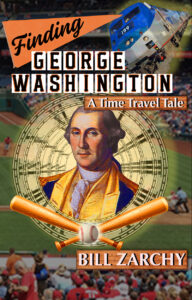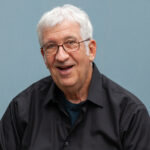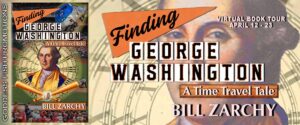 Today’s special guest author is Bill Zarchy and we’re chatting about his new sci-fi thriller, Finding George Washington: A Time Travel Tale.
Today’s special guest author is Bill Zarchy and we’re chatting about his new sci-fi thriller, Finding George Washington: A Time Travel Tale.
During his virtual book tour, Bill will be awarding a $50 Amazon or Barnes and Noble (winner’s choice) gift card. To be entered for a chance to win, use the form below. To increase you chances of winning, feel free to visit his other tour stops and enter there, too!
Bio:
Bill Zarchy filmed projects on six continents during his 40 years as a cinematographer, captured in his first book, Showdown at Shinagawa: Tales of Filming from Bombay to Brazil. Now he writes novels, takes photos, and talks of many things.
Bill’s career includes filming three former presidents for the Emmy-winning West Wing Documentary Special, the Grammy-winning Please Hammer Don’t Hurt ‘Em, feature films Conceiving Ada and Read You Like A Book, PBS science series Closer to Truth, musical performances as diverse as the Grateful Dead, Weird Al Yankovic, and Wagner’s Ring Cycle, and countless high-end projects for technology and medical companies.
His tales from the road, personal essays, and technical articles have appeared in Travelers’ Tales and Chicken Soup for the Soul anthologies, the San Francisco Chronicle and other newspapers, and American Cinematographer, Emmy, and other trade magazines.
Bill has a BA in Government from Dartmouth and an MA in Film from Stanford. He taught Advanced Cinematography at San Francisco State for twelve years. He is a resident of the San Francisco Bay Area and a graduate of the EPIC Storytelling Program at Stagebridge in Oakland. This is his first novel.
Welcome, Bill. Please tell us about your current release.
Finding George Washington: A Time Travel Tale is a sci-fi blend — after all, people do travel through time — with strong notes of history, baseball saga, and action thriller. Here’s the idea: General George Washington walks away from his encampment at Valley Forge on a very cold night in 1778 … and vanishes … only to turn up at a dog park on the shore of San Francisco Bay in the summer of 2014. Some new young friends take him in, but they are at a loss as to what to do with him. They introduce him to 21st-Century civilization — and baseball!
Eventually, they realize that the world around them is changing, transforming incrementally into an impoverished, colonial backwater, and they begin to wonder what would happen to the American Revolution if Washington never returned to Valley Forge? And what about the history of the world and many wars of liberation over the centuries that took inspiration from the American Revolution? George and his new friends find themselves in a race against time to save the world they still can remember.
What inspired you to write this book?
As a kid, I loved the presidents, and George Washington in particular. I had a set of president cards my dad gave me, nearly complete from GW to FDR. They were smaller than baseball cards and all black-and-white. But like baseball cards they had each “player’s” picture and dates on the front of the card and a list of accomplishments on the back.
Washington in particular fascinated me, because his pre-industrial world was vastly different from mine. I began to imagine having to explain how things worked to him, things like cars and trains and cameras and planes and rocket ships. At some point, when I decided I wanted to write fiction, this old mental game jumped back into my consciousness, and I realized it was time to bring George to the present. Finding George Washington is the result of this fanciful thinking, bolstered by seven years of meticulous research and writing.
Excerpt Finding George Washington: A Time Travel Tale:
From the chapter titled “Kiss:”
(George Washington and his new friends are attending a San Francisco Giants game.)
George assessed the athletes on the field.
“They are mostly fine, strapping lads who would make good soldiers. Tall, muscular, confident. At first, I doubted that anyone could throw as accurately as your fantastical head game presupposes, aiming with great precision for one side of the platter or the other.”
“The plate.”
“Yes. Seeing these bowlers and batsmen in action, in person, from so close, I can see that they are quite skilled and practiced at what they do. Your Gigantics are quite good.”
“Giants.”
He regarded me with a stony face, a hint of a twinkle in his blue eyes. I looked over at Rachel, who silently mouthed, “He’s messing with you.”
It was a warm evening. George got overheated and removed the fuzzy panda hat. The Monterey Bay Aquarium logo appeared on the massive scoreboard looming over center field, with the words “Kiss Cam” and “Share-the-Love.” The disembodied voice of Frank Sinatra began to sing “Strangers in the Night.” Animated octopus tentacles on the screen threatened to engulf the live video images.
I had once kissed my old girlfriend Marnie on the Kiss Cam, a few months after we started dating, when things were still going well between us. I didn’t miss her, exactly. She had treated me badly. But the memory brought on pangs of loneliness. The camera focused on a young couple in the stands, who watched as their image came up on screen, then dove into a passionate smooch.
The crowd cheered. Though he still wasn’t sure what was happening, George was shocked by these indecorous public displays of affection. The camera cut to an older couple, who responded with a much more dignified buss. Light booing and laughter from the masses.
Sinatra continued to croon to “Strangers in the Night.” George was mortified.
“Timothy, this song and these people seem to be celebrating romantic liaisons of the most crude and casual type. How offensive!”
The screen cut to a pimply young guy, who practically leaped onto his cute girlfriend, attacking with a scary abundance of tongue.
“Ewww,” a girl behind us called out. Our whole section laughed.
The image on screen switched to George, with Rachel beside him. In that strong left profile shot, with his pale skin, high forehead, prominent apple cheeks, graying russet hair tied in back, and aquiline nose, he looked just like the guy on the quarter dollar.
The camera seemed to stay on them forever. Finally, with a good-natured grin, Rachel gave him a prim peck on the lips, then lingered an extra second or two. The fans screamed their appreciation.
I was speechless, overcome with dread, though not sure why. How had this happened? We had brought the Father of Our Country out in public to a baseball game in San Francisco. And his iconic face was up on a giant screen, being kissed by a woman not his wife, as Sinatra sang about getting lucky.
I shared the moment with 40,000 of my closest friends at the ballpark. I hoped all their intentions were friendly.
What exciting story are you working on next?
I’m planning a sequel to Finding George Washington: A Time Travel Tale, featuring many of the same characters. It also involves time travel and a true incident in the life of Franklin Delano Roosevelt: in February 1933, shortly after he was elected president for the first time, but before he took office, FDR was the target of an assassination attempt by a crazed gunman at a rally in Florida. The attacker had a pistol and sprayed bullets at the stage and dais, killing the mayor of Chicago and a bystander and wounding several others, but completely missing Roosevelt.
For me, learning of this unsuccessful murder attempt got me wondering what would have happened if the assassin had succeeded in killing FDR. Would the U.S. government have been able to pass Roosevelt’s proposed New Deal programs, to legislate and rally the country out of the Great Depression? Without his leadership, could the Americans be convinced and cajoled into joining the Allied forces to combat the Axis during World War II?
I think this will make a terrific, exciting, alternate-history, speculative-fiction adventure, similar in tone to Finding George Washington.
 When did you first consider yourself a writer?
When did you first consider yourself a writer?
I learned to read when I was about three years old and was reading whole books when I was five. My dad was a writer, and I’ve always felt like one too. He was a high school art teacher who wrote books on the outdoors, hobbies, and crafts, several dozen of them, and he devoted every evening, weekend, and school break to his writing.
Dad gave me an old Monarch Pioneer portable typewriter in a beat-up plywood case when I was a kid. I taught myself to type with two fingers on that machine and produced a family news bulletin with carbon paper for a short time, in order to extort money from relatives. Eventually I ended up writing for my high school newspaper and, in college, editing the campus daily. Then I went to film school and got involved in cinematography as my main profession for several decades, concentrating on pictures, not words.
A little over 20 years ago, I realized that my film work and travels abroad made for interesting and sometimes funny or poignant stories that were rarely reflected in the corporate projects we were often shooting, and I began to write them down to send out to family and friends. A number of those were published in magazines and anthologies, and eventually I collected a bunch of them for my first book, Showdown at Shinagawa: Tales of Filming from Bombay to Brazil.
For years, I belonged to a critique group with 10-12 other writers. Originally, we were all writing short travel stories, but as time went on, more and more of us began to write fiction. That’s when I began writing George. But after two-three years of soaking up lots of encouragement and support for my debut novel, I realized that the group didn’t serve my needs very well anymore. Simply put, I was writing much faster than the group’s ability to keep up. And yet, the book still took years to write and edit.
Do you write full-time? If so, what’s your workday like? If not, what do you do other than write and how do you find time to write?
When I started writing again around the turn of the last century, I was still in my prime, working as a cinematographer on film and video shoots in thirty countries on six continents. Whether I was working locally or on the road, the days were long and the work demanding. Many mornings, I had to be in Silicon Valley at 7 or 7:30, which meant driving away from home by 5:30. Then a ten-hour day on the set and a long schlep home. Then rinse and repeat the next day, and the next. On the road, the days were just as long, plus the disorientation of hotel stays, jet lag, unfamiliar crews, foreign cultures, and long flights. Sometimes I would write from my hotel room, sometimes I would save it till I got home and could clear my mind. Occasionally I did some writing in the van while being driven around an overseas city. I fit the writing in as best I could, in and around the needs of my profession and my family.
I retired from the film biz in 2015 and Finding George has mostly been a retirement project. I can write whenever I want, unencumbered by the demands of young kids, pesky work schedules, or demanding clients. But it’s not the free-to-write-nonstop Nirvana I had imagined, even during the pandemic. I still have chores, classes, fitness, meals, a pooch that needs walking, and a dear wife I love to hang out with. And then, there’s baseball. So scheduling my writing time is still difficult. Because of my many years as a freelancer, I’m still most comfortable with an irregular schedule — not chaotic, but not regimented on a daily basis.
So when you hear from some writer or other that the only way to do it is to write every day at the same time of day … that’s not me. We’re all different, and I’m blessed to have a bit of drive and the talent to move people with my words, regardless of how I manage to set those words down.
What would you say is your interesting writing quirk?
When I wrote Finding George Washington, I had imagined characters and a situation (bringing GW to the present), but I did not have a clear idea about how the plot would go. Nonetheless, I decided to start writing what I did know and hoped that the rest would fall into place. I think my process would have been more orderly if I had been able to outline the whole story, but I also know that, if I had waited to start writing until I knew the flow and the outcome, I would never have begun and would certainly never have completed the work. We’re all different, and we each have to figure out our own ways to go about telling our stories.
One more quirk: when I’m writing, I like to play soft jazz in my office. I have a playlist of Miles Davis and John Coltrane albums. It’s more than 16 hours long, and I play the 145 songs in a random order as a little background ambience to keep my brain from overheating.
As a child, what did you want to be when you grew up?
I never wanted to be an astronaut or a fireman. Those professions would take more physical bravery than I could muster. Because I’m tall, people assumed I would want to be a pro basketball player, despite my lack of aptitude at that sport. I always thought I’d be a writer and photographer, like my dad, but the writing part was delayed by decades of film and video work. My parents were convinced I’d be an engineer, but it turned out that my brain wasn’t analytical enough for that profession, and my math abilities were stalled before grasping calculus. My dad had a huge font of knowledge about many subjects, and I think I eventually chose cinematography because it was something he didn’t know much about. But I didn’t figure that out until grad school in film at Stanford.
Links:
Website | Blog | Author website | Facebook | Amazon paperback | Kindle


Thanks for hosting!
Thanks so much for hosting me today. Let me know if you have any questions about me or my work.
I think that the questions and answers section of this post was fun to read.
Thank you!
Sounds like a good book.
It’s a lot of fun, exciting, unpredictable … and well researched. Enjoy!